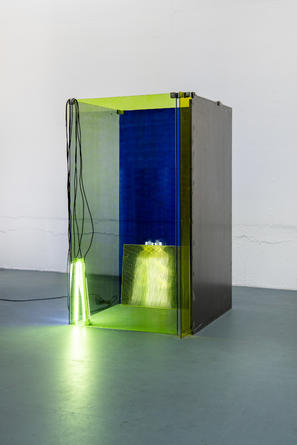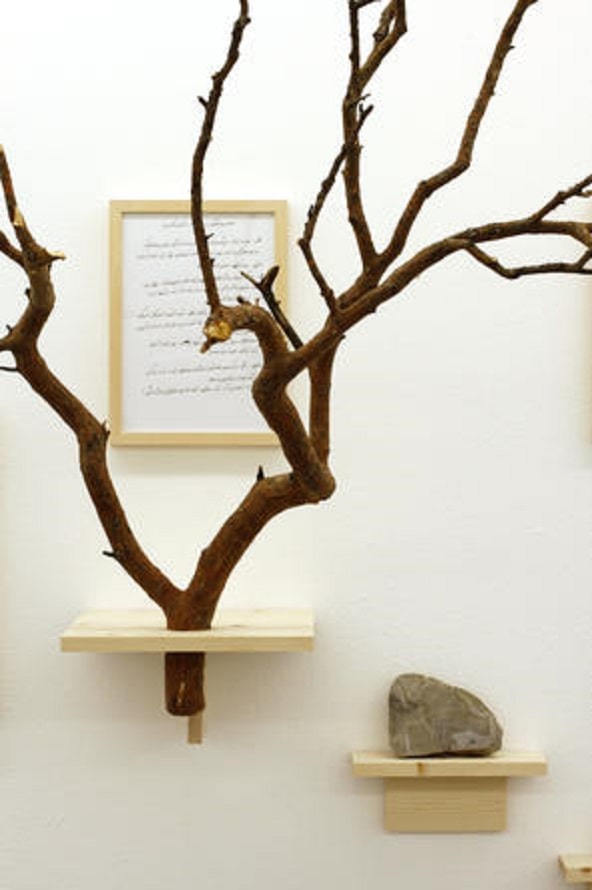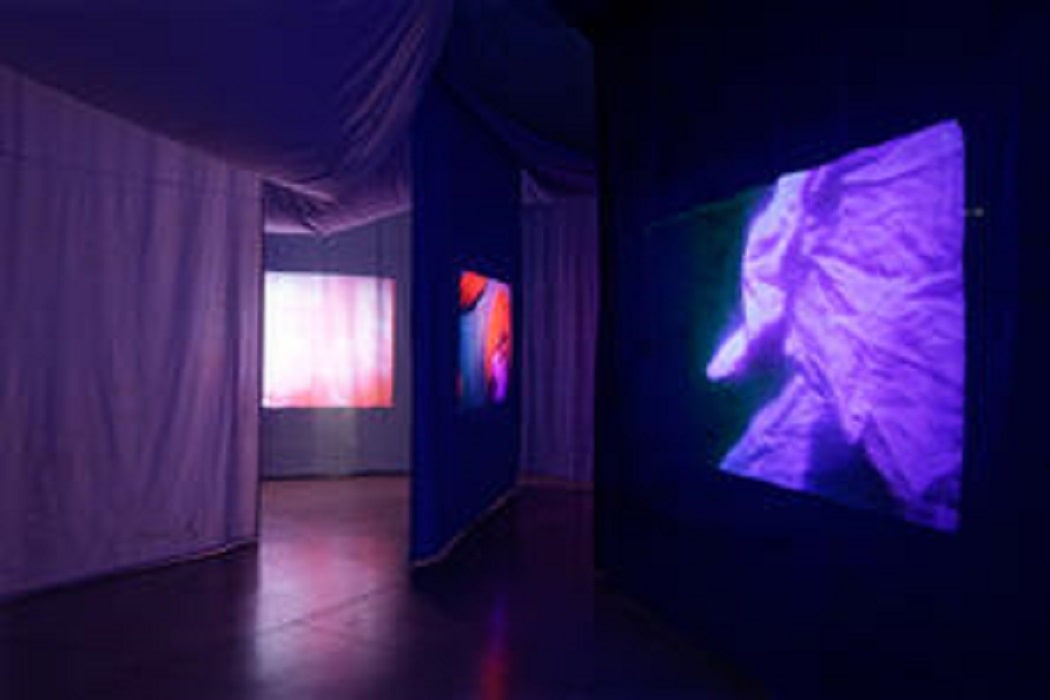The “Kubus” art prize, jointly established by Sparda-Bank Baden-Württemberg and the Kunstmuseum Stuttgart, will be awarded for the fifth time in 2022. Since 2015, it has had an overriding thematic focus. This year, three artists who address sculptural issues from different perspectives have been nominated. From 24 September 2022, Ulla von Brandenburg, Camill Leberer and Ülkü Süngün will show their works at the Kunstmuseum Stuttgart. A jury will award the prize for one of the presentations during the exhibition period. However, it is not only the jury that decides: with an additional public prize offered by the Sparda Bank, visitors can also vote until the end of the exhibition.
Image above: Ulla von Brandenburg Personne ne peint le milieu, 2019 Gefärbte Stoffe und fünf Super-16mm-Filme, übertragen auf HD-Video, Farbe, stumm Ausstellungsansicht Palais de Tokyo, Paris, 2020 Foto: Aurélien Mole Courtesy Ulla von Brandenburg und Art : Concept (Paris), Meyer Riegger (Berlin/Karlsruhe), Pilar Corrias Gallery (London), Produzentengalerie Hamburg © Ulla von Brandenburg.
The 20,000 euro “Kubus. Sparda Art Prize” is distinguished by two special features: On the one hand, it honours an outstanding visual artistic achievement regardless of the age of the artist; the art prize is thus neither a promotional prize for up-and-coming artists nor a recognition prize for a lifetime’s work of art. In this way, an open view of the broad spectrum of artistic creation in Baden-Württemberg is to be maintained. The only formal prerequisite for participation is a biographical connection to the state of Baden-Württemberg – the artists can be born here or have shifted the focus of their artistic work here. On the other hand, the three candidates will present themselves with selected works in their own rooms in the museum before the actual award ceremony. This enables the public to encounter the artistic work in an unbiased way.
The nomination and awarding of prizes are tied to a multi-stage procedure. In a first step, around 15 representatives of art and cultural institutions in Baden-Württemberg nominate two artists on a specific theme. Afterwards, a first jury – in 2022, this jury included representatives of the Kunstmuseum Stuttgart, Dr. Brigitte Franzen (Director Senckenburg Naturmuseum Frankfurt), Prof. Peter Gorschlüter (Director Museum Folkwang) and Johann Holten (Director Kunsthalle Mannheim) – selects three positions from the submitted proposals. A second jury will decide on the winner; the announcement will be made on 4 November 2022. In addition to the jury prize, the Sparda-Bank has once again offered a public prize of 5,000 euros. Visitors can vote until the end of the exhibition.
The artists proposed for this year’s edition address sculptural questions from different perspectives and put them up for discussion with their presentations at the Kunstmuseum Stuttgart. The works by Ulla von Brandenburg, Camill Leberer and Ülkü Süngüner demonstrate the diversity within contemporary sculpture. For a long time, figurative sculptures and sculptures dominated the art scene, but in the course of the last century, efforts were increasingly made to expand the art genre to include the theme of ‘space’ and the experience of space. In this updated form of sculpture, sculptural-plastic formulations are joined by installations and performative stagings that have a common frame of reference in the stage-like. Space, which is also cultural and social space, plays an essential role.
In the multimedia installations by Ulla von Bradenburg (*1974 in Karlsruhe, lives and works in Paris and Karlsruhe), elements from theatre, dance and folklore merge into stage-like productions. The artist intervenes in the sober architecture of the White Cube by means of colours, floor-to-ceiling fabric panels, sculptural objects, videos and performances, thus creating sensually charged spaces in which the visitors can immerse themselves. In the process, the boundaries between performance and reality, between performer and audience, become blurred.
The video installation “Personne ne peint le milieu” (2019) immerses visitors in a shimmering blue semi-darkness; they move through a labyrinth of fabrics floating in space. Videos projected onto the fabrics are reminiscent of underwater shots after a shipwreck. Thus, various objects – a mirror, shoes, a tambourine – seem to slowly sink into the depths.

Human forms of interaction and communication, which take place via symbolically charged objects, song or dance, are the focus of Ulla von Brandenburg’s dramatically staged performances. These deliberately break with the rules of classical theatre, to which she refers several times in the exhibition.
With the installation “Color Notation” (2022), the artist transforms the white cube, which is usually intended to draw the viewer’s attention solely to the exhibits, into a colourful fabric backdrop for various objects whose staging follows a different pattern. Instead of bringing them into focus, von Brandenburg focuses on their disappearance, the traces they leave behind. In the video “The Objects” (2009), the camera repeatedly loses sight of the objects that give the title. Rectangular silhouettes on the fabrics are reminiscent of shadows of paintings that have long since been taken down; watercolours stand on the floor as if casually.
The work of Camille Lebrer (*1953 in Kenzingen, lives in Stuttgart) focuses on sculptural constructions that correspond with independent groups of works from the fields of painting, graphics and photography. Characteristic of his works is the interplay of the materials used: heavy industrial iron meets fragile glass, transparent lacquers meet opaque colours. The pure iron surface appears raw and forbidding, but gestural traces of a grinding machine lend it a sensual effect.

Foto: Frank Kleinbach Courtesy Galerie Schlichtenmaier © VG Bild-Kunst, Bonn 2022
The construction principle of the large sculptures such as “Lichtung” (2009) or “Nachbild – Lichtfaden” (2021) picks up on central keywords of the spatial sculptural discourse: Volume, Emptiness and Boundary. The works are reminiscent of modern architectures made of steel and glass, which have a close connection to constructive sculpture. Integrated into the structure of the exhibition space, they confront the viewer with their presence; the space becomes an event space in which work and visitor meet.
The motif of the boundary between inside and outside is repeatedly declined on the material stock. In “Glashaut 2” (2022), incident light refracts in the coloured glass and spills into the interior. At the same time, artificial light penetrates from the interior to the outside. This osmotic exchange is reminiscent of the way human skin functions. In “Skin – Body” (2021), the artist takes up the theme of touch: The graphic sheets show fruit stalks and plants that trigger skin irritations.
Leberer’s photographs show scenic arrangements of coloured glasses, plants and metal parts as well as detailed shots of realised objects, with the camera looking from the outside in. In the multi-part, three-dimensional wall work “Ambivalent Space – Ascending” (2022), a change of perspective takes place: The optical grid of painted glass over a stainless steel surface imagines the view from a merely imagined spatial sculpture.
Ülkü Süngün (*1970 in Istanbul, lives in Stuttgart) works in a project- and process-oriented way in different media such as performance, installation and photography. With the founding of the “Institute for Artistic Migration Research” in 2017, she makes her social and socio-critical investigations into migration and identity visible, such as in the video installation “Gemeingut Jungbusch”, which was created in 2020 in the migrant-dominated Jungbusch district of Mannheim on the role of cultural institutions in the neighbourhood. In participatory performances such as “Takdir” (since 2018), in which Süngün practices the correct pronunciation of the names of the NSU murder victims with visitors, she creates temporary monuments that invite reflection on the culture of remembrance in public space.

“Lauter Steine” and “Lacrimarium Europae” are parts of the group of works “Anlatsam Roman Olur / Die besten Romane schreibt das Leben” (2014-2016), which tells of the living conditions and fears of refugees in Germany. The staged photo novel “Lauter Steine” describes the everyday life of the Georgian stonemason Sergio Pipa and his seriously ill wife Marina Tsertsvadze, who live in an asylum shelter. Further research by the artist on the subject of asylum is incorporated into the installation “Lacrimarium Europae”: objects, pictures and documents refer to migrants’ strategies for action that are intended to avert the threat of deportation or to have a positive influence on an open asylum procedure.
In the photo series “Transitional Objects” (2011-2012), Süngün explores the question of what constitutes cultural identity and home from her personal perspective. She finds everyday objects in Turkish shops in Stuttgart and makes them the material for her sculptural arrangements, which only survive as photographs. These tell of Turkish culture lived in Germany and may be foreign to many because they are little familiar with the objects and their original function.
In 2013, the art prize “Kubus” was awarded for the first time. The nominees at that time were Alexander Roob, Katrin Mayer and Thomas Locher. The prize winner was the long-time professor at the Academy of Fine Arts in Stuttgart, the chronicler and draughtsman Alexander Roob. In 2015, on the occasion of the 10th anniversary of the museum, a theme was defined for the exhibition: Art and Music. Nevin Aladağ, the performance duo Discoteca Flaming Star and the pioneer of interactive music installations, Peter Vogel from Freiburg, were chosen. The awarding of the prize to Peter Vogel made the artist known to a broad audience in this country. The 2017 exhibition was dominated by “extended painting”, which was reflected in many facets in the works of Corinne Wasmuht, Myriam Holme and Leni Hoffmann. Myriam Holme won over the jury with her expansive works that oscillate between painting and sculpture. In 2019, the “Kubus” was dedicated to the medium of photography. Sinje Dillenkofer, Peter Granser, Annette Kelm and Armin Linke were nominated, with the latter receiving the prize.
WHEN?
Exhibition dates: 24 September 2022 – 8. Januar 2023
WHERE?
Kleiner Schlossplatz 13
70173 Stuttgart






